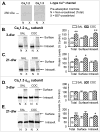Plasticity of L-type Ca2+ channels after cocaine withdrawal
- PMID: 19360908
- PMCID: PMC2862660
- DOI: 10.1002/syn.20651
Plasticity of L-type Ca2+ channels after cocaine withdrawal
Abstract
Increased reactivity of certain frontal cortical brain regions to cocaine re-exposure or drug-associated cues in cocaine-abstinent human addicts is linked to drug craving. Similarly, in rats tested after withdrawal from repeated cocaine exposure, cocaine or other strong excitatory stimuli produce greater activation of pyramidal neurons in the medial prefrontal cortex (mPFC). Our recent findings indicate that the increased mPFC neuronal activation depends primarily upon enhanced voltage-sensitive Ca(2+) influx, most likely through high-voltage activated (HVA) L-type Ca(2+) channels, but the mechanism underlying the enhanced Ca(2+) currents is unknown. In this study, we used a protein crosslinking assay to show that repeated cocaine injections, resulting in behavioral sensitization, increased total protein levels and cell surface expression of HVA-Ca(v)1.2 L-type channels in pyramidal neurons in deep layers of the mPFC. These changes in Ca(v)1.2 L-channels were time dependent and subtype specific (i.e., differed from those observed for Ca(v)1.3 L-channels). Furthermore, we found enhanced PKA activity in the mPFC of cocaine-sensitized rats that persisted for 21 days after withdrawal. PKA phosphorylation of L-channels increases their activity, so Ca(2+) currents after cocaine withdrawal could be enhanced as a result of both increased activity and number of HVA-Ca(v)1.2 L-channels on the cell surface. By increasing the suprafiring threshold excitability of mPFC pyramidal neurons, excessive upregulation of HVA L-channel activity and number may contribute to the cortical hyper-responsiveness that enhances vulnerability to cocaine craving and relapse. More generally, our results are the first to demonstrate that repeated cocaine exposure alters the membrane trafficking of a voltage-sensitive ion channel.
Conflict of interest statement
Figures



Similar articles
-
Repeated cocaine administration increases voltage-sensitive calcium currents in response to membrane depolarization in medial prefrontal cortex pyramidal neurons.J Neurosci. 2005 Apr 6;25(14):3674-9. doi: 10.1523/JNEUROSCI.0010-05.2005. J Neurosci. 2005. PMID: 15814798 Free PMC article.
-
Repeated cocaine exposure decreases dopamine D₂-like receptor modulation of Ca(2+) homeostasis in rat nucleus accumbens neurons.Synapse. 2011 Feb;65(2):168-80. doi: 10.1002/syn.20831. Synapse. 2011. PMID: 20665696 Free PMC article.
-
Repeated cocaine treatment enhances HIV-1 Tat-induced cortical excitability via over-activation of L-type calcium channels.J Neuroimmune Pharmacol. 2014 Jun;9(3):354-68. doi: 10.1007/s11481-014-9524-6. Epub 2014 Feb 25. J Neuroimmune Pharmacol. 2014. PMID: 24567038 Free PMC article.
-
Cocaine withdrawal and neuro-adaptations in ion channel function.Mol Neurobiol. 2007 Feb;35(1):95-112. doi: 10.1007/BF02700626. Mol Neurobiol. 2007. PMID: 17519508 Review.
-
Comparison of cocaine- and methamphetamine-evoked dopamine and glutamate overflow in somatodendritic and terminal field regions of the rat brain during acute, chronic, and early withdrawal conditions.Ann N Y Acad Sci. 2001 Jun;937:93-120. doi: 10.1111/j.1749-6632.2001.tb03560.x. Ann N Y Acad Sci. 2001. PMID: 11458542 Review.
Cited by
-
Effect of fendiline on the maintenance and expression of methamphetamine-induced conditioned place preference in Sprague-Dawley rats.Psychopharmacology (Berl). 2014 May;231(9):2019-29. doi: 10.1007/s00213-013-3347-7. Epub 2013 Nov 22. Psychopharmacology (Berl). 2014. PMID: 24264565 Free PMC article.
-
Repeated cocaine exposure increases fast-spiking interneuron excitability in the rat medial prefrontal cortex.J Neurophysiol. 2013 Jun;109(11):2781-92. doi: 10.1152/jn.00596.2012. Epub 2013 Mar 13. J Neurophysiol. 2013. PMID: 23486201 Free PMC article.
-
Chronic cocaine disrupts mesocortical learning mechanisms.Brain Res. 2015 Dec 2;1628(Pt A):88-103. doi: 10.1016/j.brainres.2015.02.003. Epub 2015 Feb 20. Brain Res. 2015. PMID: 25704202 Free PMC article. Review.
-
L-type calcium channel regulation of dopamine activity in the ventral tegmental area to nucleus accumbens pathway: Implications for substance use, mood disorders and co-morbidities.Neuropharmacology. 2023 Feb 15;224:109336. doi: 10.1016/j.neuropharm.2022.109336. Epub 2022 Nov 19. Neuropharmacology. 2023. PMID: 36414149 Free PMC article. Review.
-
Learning-induced intrinsic and synaptic plasticity in the rodent medial prefrontal cortex.Neurobiol Learn Mem. 2020 Mar;169:107117. doi: 10.1016/j.nlm.2019.107117. Epub 2019 Nov 23. Neurobiol Learn Mem. 2020. PMID: 31765801 Free PMC article. Review.
References
-
- Castner SA, Williams GV. Tuning the engine of cognition: a focus on NMDA/D1 receptor interactions in prefrontal cortex. Brain Cogn. 2007;63:94–122. - PubMed
-
- Davare MA, Avdonin V, Hall DD, Peden EM, Burette A, Weinberg RJ, Horne MC, Hoshi T, Hell JW. A beta2 adrenergic receptor signaling complex assembled with the Ca2+ channel Cav1.2. Science. 2001;293:98–101. - PubMed
Publication types
MeSH terms
Substances
Grants and funding
LinkOut - more resources
Full Text Sources
Miscellaneous
